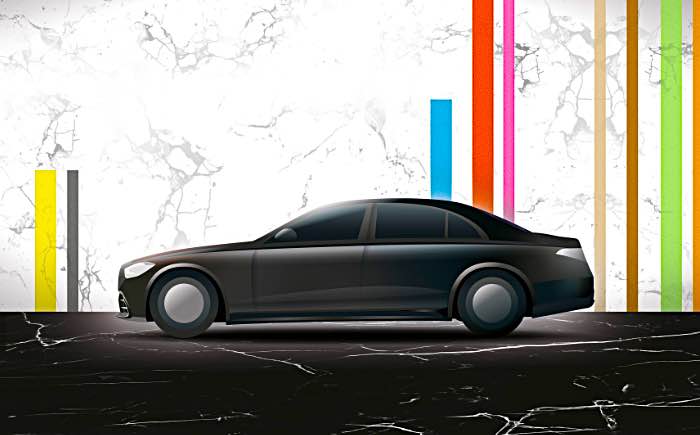
伝統的なボディカラー選びで無彩色支持が依然優勢になっている
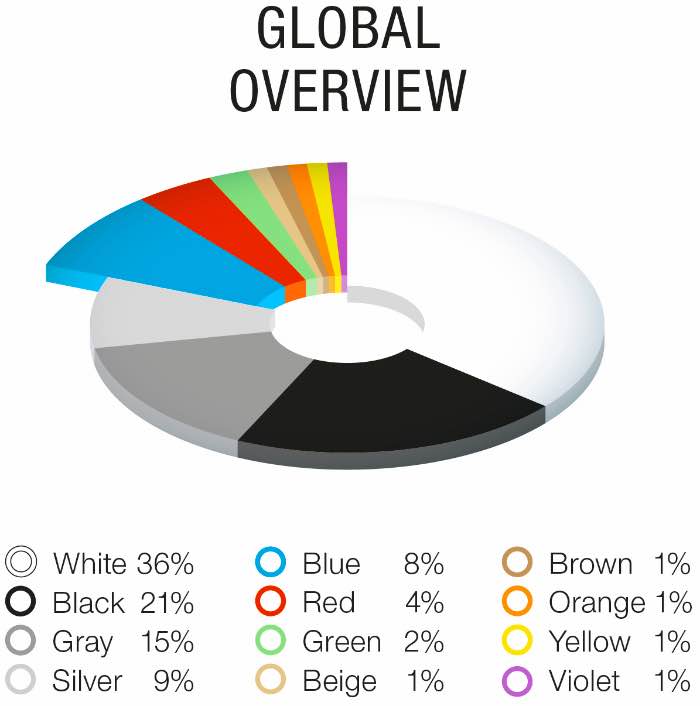
BASFは1月17日、昨年秋に発表した自動車のカラートレンドのレポートに於いて、従来から支持されてきたボディカラー選びの推移が大きな変革期を迎えているとした。
例えばホワイトは、世界規模で自動車ユーザーから選ばれるボディカラーとして一定の地位を維持し続けてきているが、実の所、そのシェアは減少傾向にある。対してブラックを好む層は拡大傾向にある。いずれも同じ無彩色のグループであるが、今日に於いては、ブラックがホワイトのシェアを奪う勢いとなっている。
そうした無彩色に係る選択をより細かく見ていくと、地域によって少し好みが異なるケースもある。一例を挙げると北米地域では、暗いグレーよりも明るいシルバー傾向の発色がが好まれる傾向にあり、対してEMEA(Europe, the Middle East and Africa/欧州・中東・アフリカ)の自動車ユーザー達の間では、近年、より暗い色合いに傾きつつある。
このような地域別の傾向は、世界のカラートレンド分布で興味深い検討要素を提供してくれる。ちなみに先の無彩色に比べると有彩色は、どの地域に於いても様々な色彩が受け入れられており、世界規模で有彩色をグループとして括った分布では、多くのボディカラー選択に於いて手堅い(19%)支持がある。
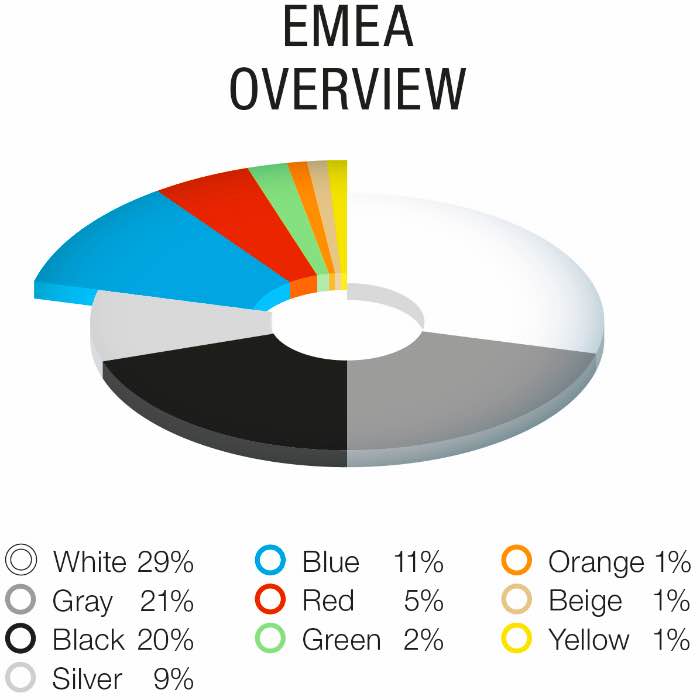
EMEAは、無彩色の人気に関して共通しているも有彩色の好みは様々
例えばEMEAに於ける無彩色は、昨年2ポイント増加したのだが、その中身は、ホワイトやシルバーなどの明るいカラーから、ブラックやグレーの暗い色合いが数多く選択されるようになっている。特にプレミアムな車種には、エントリークラスやミドルクラスの車種よりも、多くのエフェクト顔料が使用されているため、カラー自体の深みと共に創造性でも特別な傾向を持っている。
対して有彩色では、欧州・中東・アフリカの3地域に跨がるEMEAに於いて、地域毎の有彩色選びで、国特有の嗜好がある。そもそも有彩色では、ブルー、レッド、ブラウン、ベージュなど幅広いカラーがある訳だが、個々地域毎の好みに関しては、世界規模で共通傾向を示す無彩色と比べて、個性的な分布が見られるのが大きな特徴と言えるだろう。
より具体的にはドイツはブルー(11%)、スペインとイギリスはレッドとオレンジ(約9%)、フランスはグリーン(6%)を好む傾向がある。加えてイタリアは全ての有彩色に対して、他国に比べると数多くの色数が選ばれており、実際、全5ヶ国の中で最も有彩色を選ぶ傾向が高い(30%)地域だとしている。
こうした地域や国毎の違いについて、BASFの自動車カラーデザイン部門のグローバル責任者であるマーク・グ-トヤール氏は、「無彩色については、一貫して根強い人気がありますが、有彩色には各国の好みの色域があります。主要なEMEA諸国には、個々に異なるカラー分布が見られます。
翻(ひるがえ)って、私たちのお客様である自動車メーカー各社は、現在、自動車販売店に於ける個々のプランドチャンネルを窓口に、個性あるボディ色の選択肢を幅広く提供しており、自動車購入層は、そうした提案を進んで楽しんでいる傾向があります」と話す。
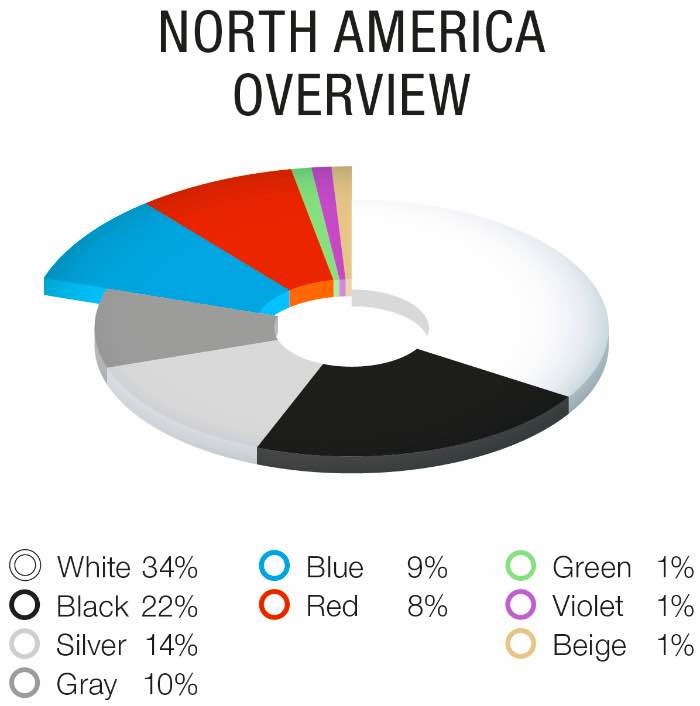
北米は、明るい無彩色とより多くのエフェクト顔料の出現
そのEMEAと同様に、北米でも無彩色に係るニーズは全体で2ポイント増加した。そのトレンドの推移は、まず幾つかのグレーが廃色にされた後、消費層は明るいカラーへと選択肢に移し、現在、それらの大半はシルバーに置き換わっている。
また特に北米では昨年、他の地域に比べてレッドを求める傾向が他地域と比較して最も高くなった。しかしそれでも近年、北米で根強い人気を保ち続けるブルーには、一歩及ばなかった。
こうした傾向について北米担当カラーデザイナーのエリザベス・M・ホフマン氏は、「他の地域に見られるのと同じ変化が私たちの調査エリアでも起きています。古い標準カラーパレットはもう使われていません。
今は明るい色合いに人気が集まっており、グレーから次第に市場シェアを奪いつつあります。明るいカラーに、強さと高揚を与えるエフェクト顔料を使用する選択肢が日増しに増えているのです」と話す。
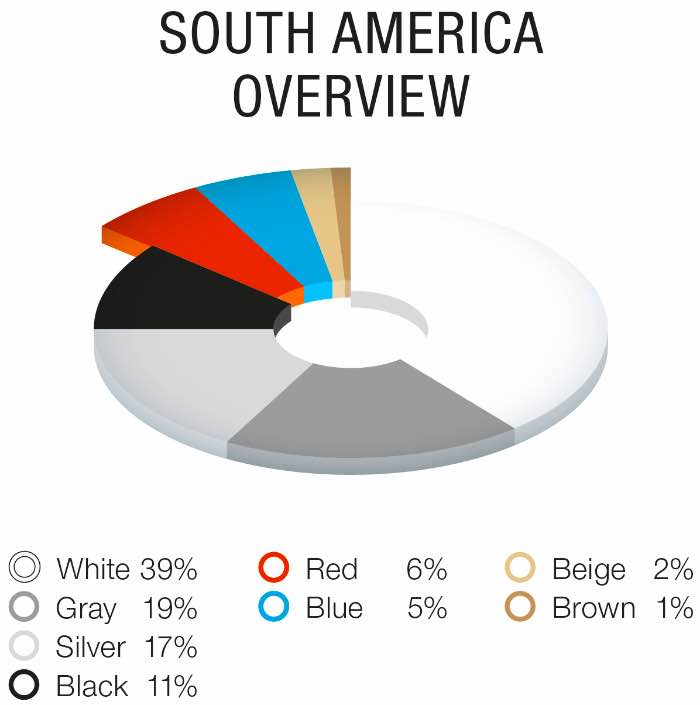
南米は引き続き無彩色の選択肢が最も多くを占める地域に
そこから南下した南米では、歴史的に自動車カラーに対して保守的なアプローチが取られており、2023年も無彩色が大部分を占める。
南米で組み立てられた新車の86%は、ホワイト、ブラック、シルバー、またはグレーのボディが全地域の中で最も多い。シルバーの割合も南米が最も高い。
このような状況を受け、無彩色でもクルマを目立たせるためエフェクト顔料を選択する自動車メーカーが増えている。具体的に2022年と比較して、全てのボディーサイズで、より多くの車にエフェクト顔料が使用された。
この傾向についてBASFコーティングス事業部南米担当ディレクターであるマルコス・フェルナンデス氏は、「カラーはもはや単なる色ではありません。
それぞれのユーザーなりの考え方に基づく体験価値を求めている結果なのです。パールでも金属フレークでも、その他の顔料でも、エフェクトにより自動車のボディカラーは見る人の目に飛び込み、興味を引き出します。それは社会での人気の高まりにつれて、価値が深まり、よりエモーショナルな魅力を引き出すようになります」と説明している。
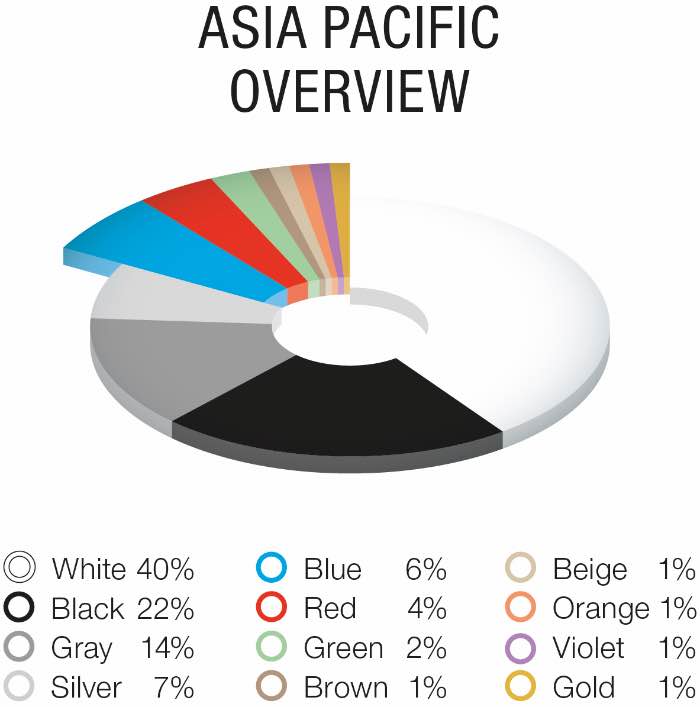
アジア太平洋地域は豊富なエフェクトバリエーションを持つ有彩色が増加
米大陸と大海原を隔てたアジア太平洋地域では、有彩色が新しい自動車カラーパレット上で主導的地位を維持し続けたため2022年と比較してわずかに増加した。特にナチュラルカラーの人気が高く特にグリーンが増加した。明るいカラー、とにかく明るいグレー系やシルバーの人気が高い。
この地域のカラー選択に関して、消費者がの志向がより多彩である理由の1つは、ボディータイプの豊富さにある。例えば新エネルギー車(NEV)にはグリーンとパープルの影響を受けたカラーなど斬新なカラー傾向も見られる。
そのような傾向についてアジア太平洋地域で自動車カラーデザインの責任者を務める松原千春氏は、「様々な新しい自動車が登場するにつれて、より生き生きとしたカラーパレットが現れるのは自然なことです。
新興自動車メーカーはアジアで新車を開発する中で、通常の色域以上のものを求めています。彼らは新しいカラーデザインに、大胆で創造的なものを求めており、若い消費者はそれらのカラーを高く評価しています」と同地域ゆえの特徴を示した。
——————————————–
Shifting achromatic colors: white is still king, but black gained in popularity, taking market share
・The old, standard automotive color wheel is changing
・White, black, gray, and silver are still dominant for non-commercial light vehicles
・Chromatic colors remain stable
In trend research released last fall, BASF stated that the traditional automotive color wheel was going through a transformation. The recently released 2023 BASF Color Report for Automotive OEM Coatings provides hard data to back up that trend.
Achromatic colors, which have always formed the foundation of automotive color, are experiencing a significant shift. While white continues to hold its position as the most popular color for light passenger vehicles, it has seen a notable decrease in market share. In contrast, black has surged in popularity, gaining market share at the expense of white.
Consumer preferences also vary across different regions. For example, in North America, there is a growing preference for lighter shades of silver over darker grays, while in EMEA, the trend leans towards darker shades. This regional variation adds an intriguing dimension to the evolving color landscape.
Meanwhile, chromatic colors have remained stable, with no significant changes in their total market share (19%). This category includes a range of colors such as blue, red, brown, and beige, which continue to maintain their popularity among customers.
EMEA: Diverse color tastes across nations; achromatic shades reign while chromatic favorites differ
The achromatic colors – white, black, gray, and silver – gained two percentage points in Europe, the Middle East, and Africa (EMEA). Car buyers shifted away from lighter colors of white and silver, to darker shades of black and gray. Premium cars had more effects pigments than entry and mid-price classes, showing the depth and creativity of color.
When European consumers chose colors, there were country-specific preferences. Germany loves blue (11%), Spain and the UK prefer red and orange (approximately 9%), France adores green (6%), and Italy shows its love for all the colors, with its share of chromatic colors being the largest among all five countries (30%).
“While the achromatic colors are still the most popular, each country appears to have its favorite place on the chromatic realm,” said Mark Gutjahr, global head of automotive color design for BASF. “Different color distribution could be seen in each of the major EMEA countries, and in general. Our customers, the automakers, have left a lot of room for individuality and creativity in car dealerships now, and car buyers are taking advantage of that.”
North America: Lighter achromatic colors and more effects pigments show up
Like EMEA, achromatic colors in North America – white, black, silver, and gray – gained two percentage points overall. Consumers moved in a lighter direction after automakers retired several gray colors. Those were often replaced with shades of silver.
North America also had the highest share of red cars compared to other regions in 2023. However, red was not able to beat blue as the most popular chromatic color in North America.
“We’re experiencing the same shift that other regions are seeing,” said Elizabeth M. Hoffmann, color designer for North America. “The old standard color palette no longer applies. Lighter shades are getting more popular, taking market share from gray. More and more choices have effects pigments to give them intensity and excitement.”
Asia Pacific: Increasing chromatic colors with more variations in effects
Continuing its leading position in the new automotive color palette, the share of chromatic colors in Asia Pacific was slightly up compared to 2022. The popularity of natural colors increased, especially green. Lighter colors became more popular, especially light grayish colors and silver.
Part of the reason Asia Pacific is more diverse in color is for the great variation of body types. Fresh shades can be seen in New Energy Vehicles (NEVs) especially more green and purple-influenced colors.
“As various new vehicles hit the roads, it is only natural that a more vibrant color palette would follow,” said Chiharu Matsuhara, head of automotive color design for Asia Pacific. “With new automakers creating new vehicles in Asia, they are asking for something more than the usual color wheel. They want something bold and creative on their new designs, and young consumers appreciate those colors.”
South America: Continues to be the region with the largest share of achromatic colors
South America historically has a conservative approach to colors, with a huge portion of achromatic colors in 2023. A total of 86% of new vehicles assembled in South America had either white, black, silver, or gray bodies, the most among all regions. The proportion of silver is also highest in South America.
With that kind of market, more and more automakers are choosing effects pigments to make the achromatic colors stand out. More cars were delivered with effects pigments in all body sizes compared to 2022.
“Colors aren’t just colors any more. They are experiences,” said Marcos Fernandes, director, BASF Coatings South America. “Whether it’s a pearl or metal flake or other pigment, the effects make the color leap from the vehicle into the eyes of the beholder. It gives a certain flair that’s becoming more and more popular.”
The BASF Color Report for Automotive OEM Coatings is a data analysis from BASF’s Coatings division based on global automotive production and paint application to non-commercial vehicles in 2023.
